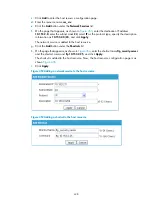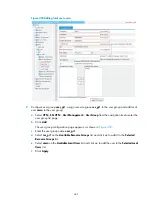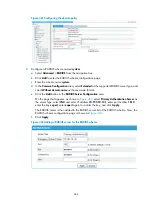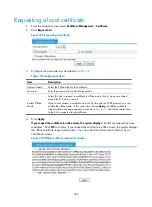
450
Step Remarks
5.
Requesting a local
certificate
Required.
When requesting a certificate, an entity introduces itself to the CA by
providing its identity information and public key, which will be the major
components of the certificate.
A certificate request can be submitted to a CA in online mode or offline
mode.
•
In online mode, if the request is granted, the local certificate will be
retrieved to the local system automatically.
•
In offline mode, you must retrieve the local certificate by an out-of-band
means.
IMPORTANT:
If a local certificate already exists, you cannot perform the local certificate
retrieval operation. This restriction avoids inconsistency between the certificate
and the registration information due to configuration changes. To retrieve a
new local certificate, you must remove the CA certificate and local certificate
first.
6.
Optional.
If the certificate to be retrieved contains an RSA key pair, you must destroy
the existing RSA key pair. Otherwise, you cannot retrieve the certificate.
Destroying the existing RSA key pair also destroys the corresponding local
certificate.
7.
Retrieving and displaying a
certificate
Required if you request a certificate in offline mode.
Retrieve an existing certificate and display its contents.
IMPORTANT:
•
If you request a certificate in offline mode, you must retrieve the CA
certificate and local certificate by an out-of-band means.
•
Before retrieving a local certificate in online mode, be sure to complete
LDAP server configuration.
8.
Optional.
Retrieve a CRL and display its contents.
Recommended configuration procedure for automatic request
Task Remarks
1.
Required.
Create a PKI entity and configure the identity information.
A certificate is the binding of a public key and the identity information of an
entity, where the DN shows the identity information of the entity. A CA
identifies a certificate applicant uniquely by an entity DN.
The DN settings of an entity must be compliant to the CA certificate issue
policy. Otherwise, the certificate request might be rejected. You must know
the policy to determine which entity parameters are mandatory or optional.
Summary of Contents for MSR SERIES
Page 17: ...xv Documents 835 Websites 835 Conventions 836 Index 838 ...
Page 20: ...3 Figure 3 Initial page of the Web interface ...
Page 42: ...25 Figure 13 Firefox Web browser setting ...
Page 59: ...42 Figure 27 Checking the basic service configuration ...
Page 73: ...56 Figure 35 Sample interface statistics ...
Page 156: ...139 Figure 139 Rebooting the 3G modem ...
Page 168: ...151 Figure 152 Configuring Web server 2 ...
Page 174: ...157 Figure 158 Configure the URL filtering function ...
Page 242: ...225 Figure 233 Enabling the DHCP client on interface Ethernet 0 1 ...
Page 247: ...230 Figure 236 The page for configuring an advanced IPv4 ACL ...
Page 255: ...238 Figure 241 Advanced limit setting ...
Page 298: ...281 e Click Apply 2 Configure Router B in the same way Router A is configured ...
Page 400: ...383 Figure 387 Verifying the configuration ...
Page 405: ...388 ...
Page 523: ...506 Figure 530 Ping configuration page ...
Page 775: ...758 Figure 785 Configuring a jump node ...
















































